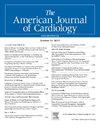2016-2020年美国高危肺栓塞治疗中的社会经济差异
IF 2.1
3区 医学
Q2 CARDIAC & CARDIOVASCULAR SYSTEMS
引用次数: 0
摘要
关于社会经济因素对高危急性肺栓塞(PE)的管理和结局的影响的数据有限。使用2016-2020年的全国住院患者样本(NIS),我们确定了高危PE(定义为PE伴有心源性休克、血管加压药使用或心脏骤停之一)的成人(≥18岁)入院。社会经济因素包括性别、种族、保险支付人和经济地位。研究结果包括住院死亡率、机械循环支持(MCS)率和最终PE干预率、住院时间和住院费用。在21,521例高风险PE住院患者中(中位年龄65岁,53%为男性,64%为白人),社会经济变量在5年期间保持稳定。MCS的使用率为4%,医疗保险和医疗补助受益人、无保险入院者和收入最低四分之一的人的使用率较低本文章由计算机程序翻译,如有差异,请以英文原文为准。
Socioeconomic Disparities in the Care of for High-Risk Pulmonary Embolism in the United States, 2016 to 2020
There are limited data on the impact of socioeconomic factors on the management and outcomes of high-risk acute pulmonary embolism (PE). Using the National Inpatient Sample (NIS) from 2016 to 2020, we identified adult (≥18 years) admissions with high-risk PE (defined as PE with one of: cardiogenic shock, vasopressor use, or cardiac arrest). Socioeconomic determinants included sex, race, insurance payer, and economic status. Outcomes of interest included in-hospital mortality, rates of mechanical circulatory support (MCS) and definitive PE interventions, hospitalization duration, and hospitalization costs. Among 21,521 high-risk PE hospitalizations (median age 65 years, 53% male, 64% white race), the socioeconomic variables remained stable during the 5-year period. MCS utilization was 4%, with lower rates of utilization in Medicare and Medicaid beneficiaries, uninsured admissions, and those from the lowest income quartile (all p <0.05). Racial minorities, those from lower economic status, and uninsured admissions received advanced PE interventions less frequently. There did not appear to be notable sex disparities in use of advanced PE therapies. Overall, in-hospital mortality was 50%, with higher adjusted in-hospital mortality in female, African American, Hispanic, uninsured, and economically disadvantaged individuals. In conclusion, significant inequities in in-hospital mortality, mechanical circulatory support, and definitive pulmonary embolism therapy utilization persist among high-risk PE hospitalizations in the United States based on sex, race, income, and insurance status.
求助全文
通过发布文献求助,成功后即可免费获取论文全文。
去求助
来源期刊

American Journal of Cardiology
医学-心血管系统
CiteScore
4.00
自引率
3.60%
发文量
698
审稿时长
33 days
期刊介绍:
Published 24 times a year, The American Journal of Cardiology® is an independent journal designed for cardiovascular disease specialists and internists with a subspecialty in cardiology throughout the world. AJC is an independent, scientific, peer-reviewed journal of original articles that focus on the practical, clinical approach to the diagnosis and treatment of cardiovascular disease. AJC has one of the fastest acceptance to publication times in Cardiology. Features report on systemic hypertension, methodology, drugs, pacing, arrhythmia, preventive cardiology, congestive heart failure, valvular heart disease, congenital heart disease, and cardiomyopathy. Also included are editorials, readers'' comments, and symposia.
 求助内容:
求助内容: 应助结果提醒方式:
应助结果提醒方式:


